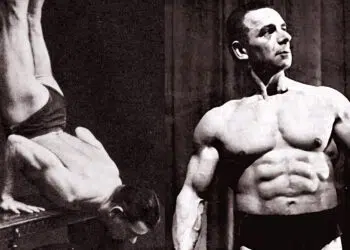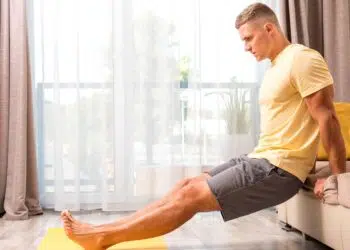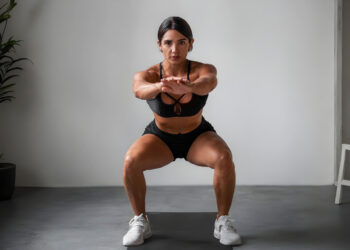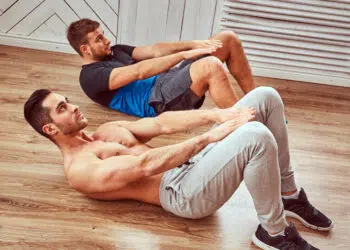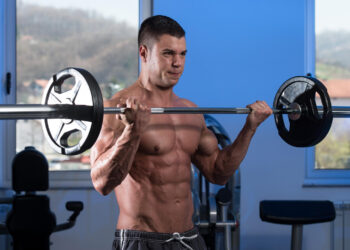The crunch is an effective exercise for strengthening your abs. But if you’re really serious about developing an impressive, functional midsection, you’ve got to introduce instability to your training. The best way to do that is with a stability ball.
I began using stability ball training with my personal training clients in the mid-1980s. My clients started doing core exercises like crunches and leg raises on the ball instead of a bench. The exercises became much more complicated, and the results came much faster.
Since then, the stability ball has become an essential core training tool in my arsenal. In this article, I’ll share my favorite 10-minute stability ball core workout, which will develop a strong, sculpted, and functional midsection.
10-Minute Stability Ball Ab Workout
This advanced stability ball ab and core workout involves alternating between 45 seconds of work and 15 seconds of rest. You must have your stopwatch in view and discipline yourself to stick to those designated work and rest times.
| Exercise | Work Time | Rest Time |
| Stability Ball (SB) Crunches | 45-seconds | 15-seconds |
| SB Prayer Crunch | 45-seconds | 15-seconds |
| SB Tabletop Crunch | 45-seconds | 15-seconds |
| SB Leg Lowers | 45-seconds | 15-seconds |
| SB Jackknife Passes | 45-seconds | 15-seconds |
| SB Dead Bug | 45-seconds | 15-seconds |
| SB Kneeling Rollouts | 45-seconds | 15-seconds |
| SB Kneeling Circles | 45-seconds | 15-seconds |
| SB Plank Climbers | 45-seconds | 15-seconds |
| SB Plank Knee Tucks | 45-seconds | 15-seconds |
Exercise # 1: Stability Ball Crunches
- Lie on the ball as if lying on a bench, with your feet firmly planted on the floor and hands alongside your ears.
- Breathe in as you lay back to extend your abdominals.
- Breathe out as you crunch forward. Rounding your shoulders and tensing your abs. Keep your lower back on the ball throughout.
Exercise # 2: Prayer Crunch
- Lie on the ball with your feet on the floor. Extend your hands above your body and clasp your hands together in the prayer position.
- Extend your upper body towards the ceiling by pulling up and contracting your core. Your hands should move 8-12 inches upward.
- Lower to bring your shoulders back to the ball and arch over it.
Exercise # 3: Tabletop Crunch
- Lie on the floor in front of the ball, resting your lower legs on it. Your knees should be bent at a right angle so that that ball is close to your hamstrings.
- Place your hands on the floor at your sides. Your shoulder blades should be on the floor.
- Contract your core to crunch up toward the ball. Simultaneously, bring your hands toward the ball.
- Return to the start position.
Exercise # 4: Leg Lowers
- Lie on the floor with your legs extended and the ball between your lower legs. Squeeze in with your ankles to hold the ball between them. Place your hands on the floor at your sides..
- Keep your legs straight, and hinge at the hips to bring the ball up toward the ceiling until your legs reach your torso at a right angle.
- Slowly lower halfway to the floor and then move into the next rep.
Exercise # 5: Jackknife Passes
- Lie on the floor with your legs extended and the ball between your lower legs. Squeeze in with your ankles to hold the ball between them. Place your hands behind your head.
- Keep your legs straight, and hinge at the hips to bring the ball up toward the ceiling until your legs reach your torso at a right angle. At the same time, bring your hands up to take hold of the ball.
- Transfer the ball to your hands and bring it over to touch the floor over your head. Simultaneously lower your legs until they are a few inches off the floor (do not touch the floor).
- On the next rep, transfer the ball back to your feet.
Exercise # 6: Dead Bug
- Lie on the floor with your knees bent and your feet off the floor. Rest the ball against your knees, holding it with your hands for support.
- Simultaneously extend your right hand overhead toward the floor and your left leg out straight. Support the ball with your left hand and knee.
- Return to the start position.
- For the next rep, extend your left arm and right leg.
- Alternate sides on each rep.
Exercise # 7: Kneeling Rollouts
- Kneel on the floor with the ball in front of you. Rest your fingertips on the ball with your arms straight.
- Roll the ball away from you to full extension.
- Roll the ball back toward you.
Exercise # 8: Kneeling Circles
- Kneel on the floor with the ball in front of you. Rest your forearms on the ball.
- Extend your torso out and around to make a circling motion to the left. Maintain control of the ball as you make as big a circle as possible.
- On the next rep, reverse the direction to make a circle to the right.
Exercise # 9: Stability Ball Mountain Climbers
- Rest your elbows on the stability ball with your legs straight and feet wide apart. Maintain a straight body (do not lift your hips) and tense your core.
- Bring your left knee toward the left elbow and return it to the ball.
- On the next rep, bring the right knee to the right elbow and return it to the ball.
Exercise # 10: Plank Knee Tucks
- Lie with your lower legs on the ball, arms extended directly under your shoulders, and palms on the floor.
- Pull the ball toward you to bring your knees toward your elbows.
- Push your legs back to full extension.
Why Use a Stability Ball for Core Training?
Core training develops strength and endurance, protecting the spine from damage and producing dynamic movements. These include the rectus abdominis, transverse abdominis, obliques, erector spinae, and multifidus muscles.
A stability ball provides a semi-stable platform to support the body during core exercises. Because the muscle activity is involuntary, it gets on with the required work rather than telling the body to do something.
Level Up Your Fitness: Join our 💪 strong community in Fitness Volt Newsletter. Get daily inspiration, expert-backed workouts, nutrition tips, the latest in strength sports, and the support you need to reach your goals. Subscribe for free!
The core muscles are recruited a split second before any limb movements, which suggests that the muscle anticipates the force that will soon be going through the lumbar spine.
Adding a stability ball to your core training will improve your balance and proprioception, which is your awareness of where your arms and legs are in space. It will challenge your muscles uniquely and effectively, leading to greater overall strength and stability.
There is a growing body of research to verify the benefits of stability ball training for the core. A 2004 study explored the core stability effects of two stability ball workouts per week for six weeks on trained athletes. The experimental group significantly improved core strength and stability more than those not trained with a stability ball. [1]
A 2010 study looked at the effect of stability ball training on strength, balance, flexibility, and endurance in sedentary women. The women trained for 45 minutes three times per week for 12 weeks. All of the women made dramatic improvements in their pre and post-exercise testing of trunk flexion (average 30-percent increase), abdominal endurance, lower back endurance, and dynamic balance. [2]
Experts agree that stability ball training is one of the best things you can do for your core. Jessica Matthews, an ACE-certified Health Coach and Assistant Professor of Integrative Wellness at Point Loma Nazarene University, made the following comment:
Level Up Your Fitness: Join our 💪 strong community in Fitness Volt Newsletter. Get daily inspiration, expert-backed workouts, nutrition tips, the latest in strength sports, and the support you need to reach your goals. Subscribe for free!
Using a stability ball for core exercises engages multiple muscle groups simultaneously, improving balance, stability, and core strength. It dynamically challenges the body, promoting functional strength and reducing the risk of injury during daily activities.
Dr. Stuart McGill is a world-famous expert in spinal health and sports performance. He is Professor Emeritus of Spine Biomechanics at the University of Waterloo. Here’s what he has to say about stability ball training for the core:
“Incorporating a stability ball into core training adds an element of instability, requiring the core muscles to work harder to maintain balance and control. This strengthens the core and enhances neuromuscular coordination and proprioception, leading to improved athletic performance and injury prevention.”
Stability Ball Training Tips
A stability ball introduces a unique challenge to your workout, requiring extra balance and coordination. Here are half a dozen tips to help you get started:
- Ease Into it: Start with simple movements like stability ball crunches and planks to allow your body to get used to the instability.
- Focus on Form: Perform your exercises slowly and under control. Maintain a neutral spine (no rounding) and continually engage your core muscles.
- Engage Your Stabilizer Muscles: Focus on stabilizing yourself by engaging your arms, legs, and back muscles.
- Maintain the Ball: Check that the stability ball is inflated correctly for your weight to give you sufficient stability. It should be firm but not overly inflated. When you press on it, your thumb should sink in slightly.
- Incorporate Balance Challenges: Once you’re comfortable with basic stability ball exercises, challenge your balance by incorporating exercises requiring you to shift your weight or stabilize on an unstable surface, such as lateral ball rolls. This can further enhance core strength and stability.
- Be Consistent: As with any form of exercise, consistency is vital to seeing results. Aim to incorporate stability ball core training into your regular workout routine and gradually progress as you build strength and stability.
FAQs
Will using an exercise ball make it more challenging?
Yes, it will, provided that you use it to enhance the exercise rather than just for the sake of it. Simply sitting on the ball won’t magically transform an exercise. The ball’s purpose is to add to the physical challenge of performing the exercise. Therefore, you should only exercise on a gym ball if doing so will make the exercise more intense.
For example, doing dumbbell curls on a stability ball will not do any more for your biceps than doing them on a bench. On the other hand, doing crunches on a stability ball will recruit the same muscles as the floor version and more.
How does the fitness ball add to an exercise?
A fitness ball can do two main things to enhance your workout:
- The flexible, tactile surface allows you to get into advantageous positions that you can’t achieve without it. These positions trick the body into working productively against its weight or external resistance. When you do the dumbbell chest press on the exercise ball, for example, you work your chest, deltoids, and triceps and use every major muscle to hold your body in position on the ball.
- Due to the ball’s unstable nature, the body generates involuntary muscle actions/activity, which allows you to target muscles that would ordinarily be less involved if the same movement was performed on a solid platform.
Will sitting on a stability ball at the office work my core muscles?
Merely sitting on a ball won’t work the deep core muscles. However, sitting on a stability ball instead of a chair will at least make you more aware of your posture during the desk-bound parts of your day. After all, it’s pretty hard to slouch on a fitness ball.
Conclusion
Stability ball training will add an intense, challenging element to your core workout. If you’re used to repping out countless crunches, the 10-minute workout detailed here will take your core training to the next level. This workout will strengthen your abs and improve overall core stability and control by engaging stabilizer muscles and challenging your balance.
Perform this workout twice to three times weekly to strengthen and define your core while enhancing functional strength for everyday activities.
References
- Stanton, Robert1; Reaburn, Peter R.1; Humphries, Brendan2. The Effect of Short-Term Swiss Ball Training on Core Stability and Running Economy. Journal of Strength and Conditioning Research 18(3):p 522-528, August 2004.
- Sekendiz, Betül1; Cuğ, Mutlu2; Korkusuz, Feza2. Effects of Swiss-Ball Core Strength Training on Strength, Endurance, Flexibility, and Balance in Sedentary Women. Journal of Strength and Conditioning Research 24(11):p 3032-3040, November 2010. | DOI: 10.1519/JSC.0b013e3181d82e70


